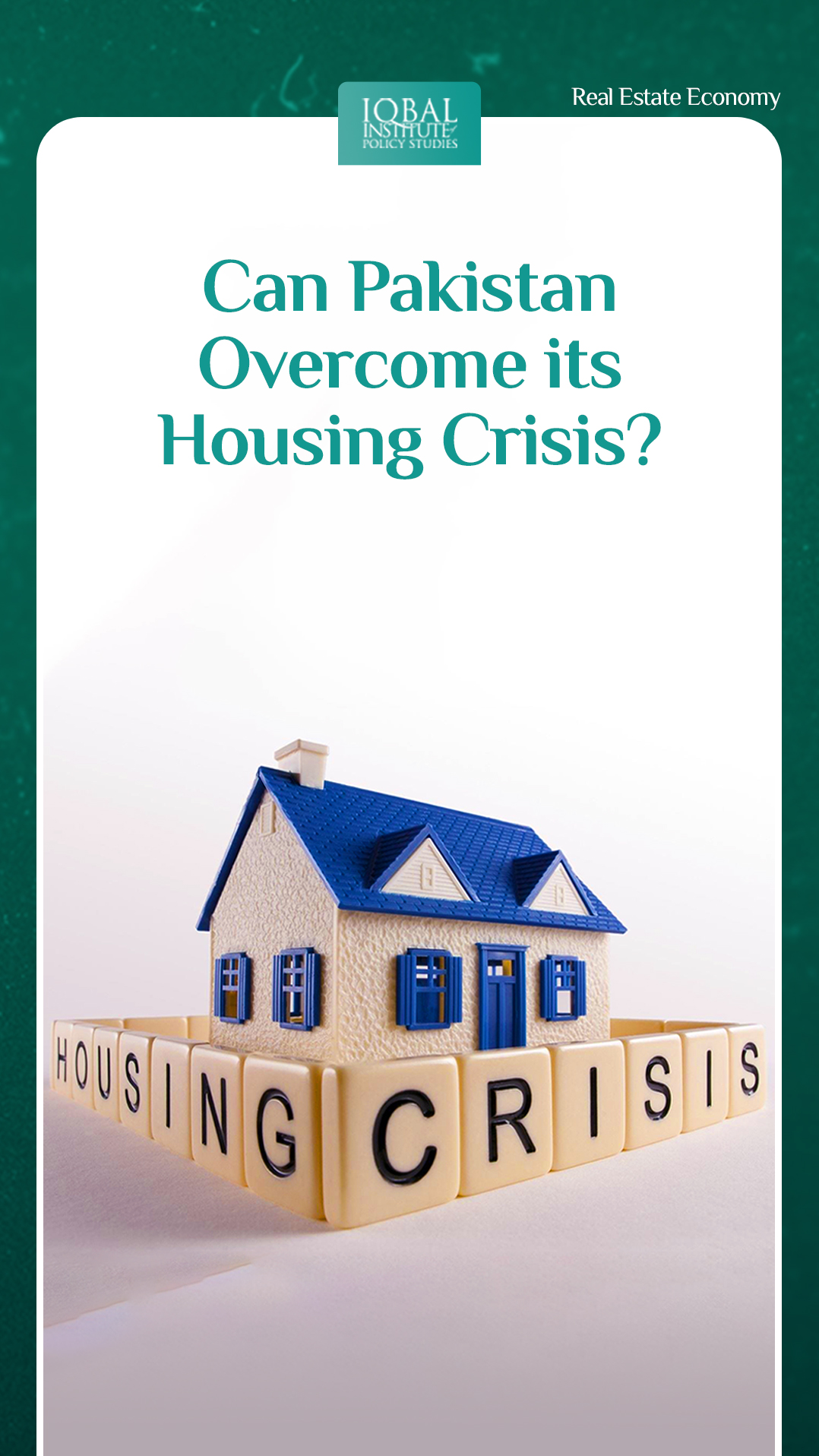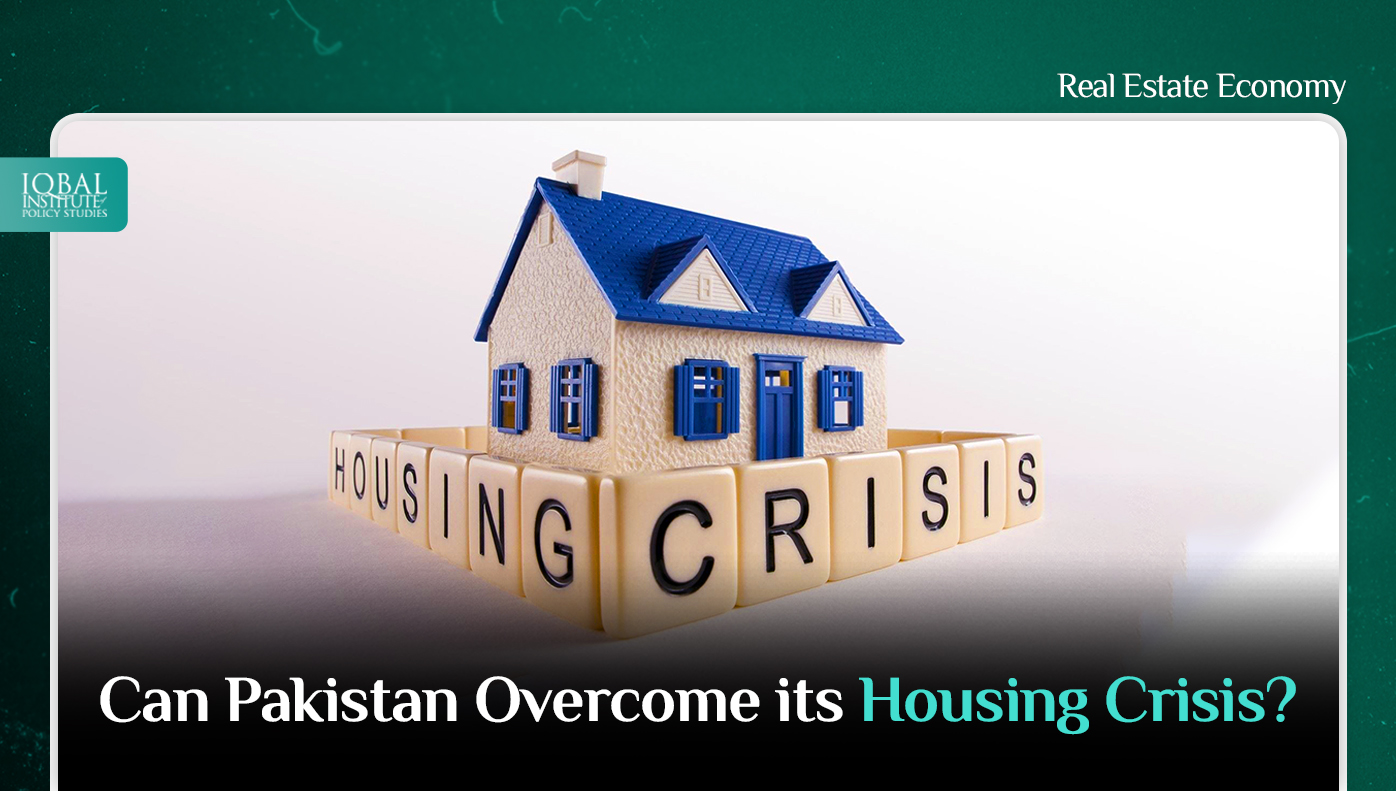Housing plays a vital role in the socio-economic development of a country. It is globally appreciated by all nations for its significance and capacity in fostering social good and creating a progressive society. It is not just a primary need, but essential for security, stability, comfort, and prosperity. Housing needs are growing with an increase in population. However, the demand is more than the supply thus leading to a housing crisis. Pakistan being the fifth most populous county in the world is also struggling to meet the increasing housing demands (world meter, 2022). This housing shortage is affecting the country’s overall progress. It is not only depriving people of their basic rights but also affects their socioeconomic conditions. The majority of the individuals with low incomes are making immense efforts to rent or buy affordable houses in big cities. However, rapid urbanisation, inflation, and acute housing shortage have led to a rapid rise in rents and house prices across Pakistan. Moreover, 40 ancillary industries which are linked with the housing sector of Pakistan are also running out of business impacting the economic growth of the country (. If the government aspires to improve the housing conditions in the country, then the formulation of smart housing policies and land reforms is the need of time. The private sector should also work with the government by mobilizing resources to meet the increasing housing demands. A better housing sector will ensure a better economy and a bright future for Pakistan.
The situation in Pakistan
Pakistan first formulated its housing policy in 2001 after 55 years of independence (Tariq, 2019). Before that, no attention was given to the housing sector. This resulted in poor infrastructure development, increasing housing issues, and homelessness in the country. Less than 0.5 % of land in the country is planned (GraanaBlog, 2021). Whereas, the ratio of the unplanned area is much higher. 40.1% of the population is living in slums due to inequality, unemployment, and lack of accommodation (Trading Economics, 2022). Moreover, the cities are expanding rapidly due to urbanisation intersecting the boundaries of other cities. No attention is directed toward the development of new cities or towns to accommodate the massive population.
Furthermore, the illegal housing schemes and horizontal development in the country are profit driven and not need-based. Some of these developments are made on floodplains or agricultural lands which get destroyed during natural disasters like floods, earthquakes, or land sliding. Moreover, rising inflation has hiked the prices of construction materials and the workforce. As a result, a common man can only dream of building a house. At present, Pakistan is facing a shortage of housing units. By 2030 Pakistan needs 20 million housing units on 1% extra land (Bhutta, 2022). The existing value of Pakistan is 600 to 700 billion dollars. If 20 million housing units are made by utilizing 1 % land then the value of the real estate will be 1.5 to 2 trillion dollars. This will not only resolve the housing crisis in the country but also run the ancillary industries associated with the housing sector, having a positive impact on the economy overall.
What are the causes of the housing crisis in Pakistan?
Rural to Urban Migration
Big cities have better opportunities, jobs, healthcare, education, and other services. As a result, people move from rural to urban areas in large numbers. Urbanisation is increasing with time, causing a spike in demand for houses. As a result, the cities are expanding to accommodate the massive population. However, the gap between the demand for housing units and supply is much higher which leads to a housing crisis. As a result, people are forced to live in slums, outskirts of cities, and in poor housing conditions.
Inflation
Inflation has resulted in a cost surge in construction and housing materials. This has forced the workforce, developers, and builders to increase the profit margin. Moreover, rent and housing prices are also outside the reach of people with low to middle income. The government does not provide subsidies on construction materials. As a result, it has become difficult for a common man to build a home leading to an increase in homelessness.
Natural Disasters
People who cannot afford homes reside in places that are riskier or low-lying prone to floods, land sliding, and toxic industries. Here the land value and cost of houses are less. When disaster strikes, these houses get destroyed. For example, the recent monsoon floods in Pakistan have destroyed 325,000 houses. The majority of these houses were near flood plains and build on unplanned areas. A large number of people are homeless and require shelter.
Inefficient use of land
Less than 0.5% of land in Pakistan is planned (Bhutta, 2022). The rest of the land is to occupied due to illegal construction, profit-driven illegal housing schemes, and horizontal development. When the government takes action by encroaching on these illegal houses, the majority of the people are displaced. The government does not regulate or keep a check on these illegal constructions and does not provide resettlement plans as well.
Lack of Low-Cost Housing
Increasing housing demands escalate the house and rent prices which leads to homelessness, and the development of slums and unhygienic ghettos in the suburbs of big cities. The majority of the slums are present on valuable commercial or residential land that can be used effectively to improve the economy of the country. However, the lack of low-cost housing schemes forces the low-income population to occupy this land.
Population Growth
Population and housing demand are directly linked. An increase in population results in an increase in housing demand and vice versa. Pakistan’s rapidly growing population is moving to urban areas due to a better lifestyle. It forces them to live in poor house conditions that give rise to various diseases and crimes. Moreover, the increasing demand has led to the development of illegal construction throughout big cities to meet housing needs.
How can Pakistan overcome the Housing Crisis?
Development of new cities and towns
The government should develop new towns and cities instead of expanding the existing ones. Moreover, rural areas should be provided with better health, education, job, and other facilities to minimise the bulk of migration from rural to urban areas.
Vertical development
Instead of investing money in horizontal projects, the government should focus on vertical projects that require limited space and can accommodate more people at once. Vertical constructions are environmentally sustainable and affordable as well.
Low-Cost Housing Projects
The housing demands come from the low-income class mostly whereas, the majority of the housing projects cater to the need of the middle or upper class. The government should focus on low-cost housing projects and provide subsidies on construction materials as well. This will provide shelter to the lower class resulting in fewer slums and ghettos within big cities.
Modular Construction
Modular buildings are constructed in sections within factories and then installed on the construction sites. These buildings are cheaper and more affordable. Moreover, the modular sections can be redesigned or re-assembled into any desired shape. These buildings are either permanent or temporary and can easily be relocated as well.
Construction from Recyclable Materials
Building homes from shipping containers or old buses are cost-efficient method. The construction of houses with these materials is much quicker than the conventional methods. It is suitable for providing shelter to people affected by natural disasters.
Resettlement of Slums
Slum areas are expanding in and around big cities of Pakistan indicating the shortage of houses. The government should build smart and low-cost houses with all the essential services to resettle the people living in slum areas. The resettlement will save the government precious commercial and residential land which can be used for future projects.
Tax Incentives
The government should revise the tax policies and tax system for the real estate sector in the country. Moreover, a subsidy should be provided on construction materials with a low tax on small houses. This will ensure the progress of the real estate sector which has the potential to meet the demand of increasing housing needs in Pakistan.
Conclusion
The current housing crisis in Pakistan requires immediate attention and a solution. Formulation and implementation of smart housing policies will not only address the increasing housing demands but also improve the business of multiple industries that are associated with the housing sector. It will also create hundreds of job opportunities for both skilled and unskilled workforce. By making smart decisions Pakistan can overcome its housing crisis which will benefit its economy and future.
References
Bhutta, Z. (2022, July 8). Real estate group seeks long-term policy. The Expess Tribune. Retrieved from https://tribune.com.pk/story/2365216/real-estate-group-seeks-long-term-policy
Desk, M. (2021, June 11). GlobalVillageSpace. Retrieved from globalvilliagespace: https://www.globalvillagespace.com/pakistans-housing-market-is-leading-the-economy-what-has-changed/#:~:text=Pakistan’s%20real%20estate%20sector%20has,cement%2C%20and%20bricklaying%20to%20cables.
GraanaBlog. (2021, 6 13). Retrieved from graana.com: https://www.graana.com/blog/the-role-of-real-estate-in-pakistans-economic-development/
Tariq, D. F. (2019, 22 6). POLICIES TO PROMOTE AFFORDABLE HOUSING IN PAKISTAN:CHALLENGES AND LESSONS LEARNED. housing research center. Retrieved from https://www.un.org/development/desa/dspd/wp-content/uploads/sites/22/2019/06/Fariha-Nairobi_Africa.pdf
Team, T. V. (2022). Pakistan floods: Map and satellite photos show extent of devastation. BBC News. Retrieved from https://www.bbc.com/news/world-asia-62728678
Trading Economics. (2022). Retrieved from tradingeconomics: https://tradingeconomics.com/pakistan/population-living-in-slums-percent-of-urban-population-wb-data.html#:~:text=Population%20living%20in%20slums%20(%25,compiled%20from%20officially%20recognized%20sources.
worldometer. (2022). Retrieved from worldometers: https://www.worldometers.info/world-population/pakistan-population/#:~:text=Pakistan%202020%20population%20is%20estimated,(and%20dependencies)%20by%20population.



Leave a Reply